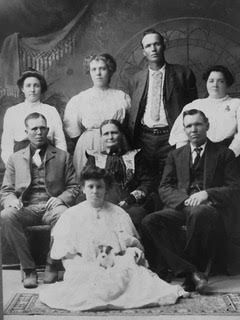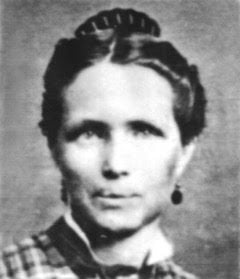In 1879, 28 people started from Show Low, Arizona territory, to settle in the Gila Valley — 11 adults and 17 children. They traveled by oxcart and walked, towed wagons up rocky inclines, and kept an eye out for raiding Apaches. Caroline Ann Schofield Teeples later recounted the journey and the settlement of the town that would become Pima, Arizona.
“I am taking the liberty to tell who the first pioneers who came to the Gila Valley were,” Caroline said in a 1929 interview, “how they were sent and what they experienced after arriving ... . Most of the earliest pioneers have passed away, but they still live in the minds of all of the true early pioneers.”
Caroline was born Nov. 3, 1851, in Northumberland, England. After her father died and her mother remarried, the family came to the United States aboard the ship “Progress.” Upon her mother’s death, her stepfather gave the children to anyone who would take them. Seven-year-old Caroline was handed over to a Mormon family on their way to Utah.
Once she was old enough to work, she boarded with different families until she became very ill. The family she was living with threw her out.
Neighbors Harriet and William Teeples nursed Caroline back to health and, with Harriet’s blessing, William married 17-year-old Caroline in 1868. She was William’s third wife although his first marriage had been dissolved.
During the ensuing years, Harriet gave birth to nine children and Caroline seven, although two of Carolina’s children died in infancy.
In October 1878, the Mormon Church called the Teeples to Arizona territory. They set out with 11 other wagons for the long journey, crossing the Colorado River by ferry and teetering dangerously close to careening down steep precipices as they maneuvered narrow passageways.
Every horse was needed to haul just one wagon up and over near-vertical cliffs.
The threat of Indian attacks added to their fears. It was a grueling, dangerous journey.
The company finally arrived near Show Low and started a small settlement, but the land was not suited for farming. William, having explored the Gila Valley and appreciating the rich, fertile land there, convinced several families to move deeper into the territory.
In March 1879, Caroline bundled up her young children, grabbed the reins of a wagon and held onto to her baby as they headed south.
Throughout her travels, she maintained she drove “team and wagon all the way from Utah and was only helped twice in two bad places. I drove up Seven Mile Hill all right but before we could get over the Black Hill, we had to stop and blast rocks one whole day.”
The road was rough and the journey long. Reaching Fort Apache, they stocked up on supplies and were warned to look out for Apaches. They encountered none until they arrived at the Gila River and the women began preparing the noon meal.
“The men and boys went in swimming,” Caroline said, “and afterwards caught some fish. I was getting the dinner ready. I had a plateful of nice fried fish and a plate of warm bread ready for the table. There was a young Indian standing near; he watched his chance and when I wasn’t looking he grabbed both bread and fish and ran. I then had to cook more bread and fish and this time kept it from the sight of the Indians.”
Arriving in the Gila Valley on April 8, Caroline recalled, “Tents were pitched and a townsite laid out into lots. ... Each man went to his lot and went to work to improve it. They went to the river to cut cottonwood logs with which to build their homes, and exchanged work in building them.”
William constructed a home that would accommodate his wives: two wings with a connecting covered breezeway that served as the family’s living and dining area.
Initially crude, brush shelters served as kitchens, cattle were held in a public corral and water hauled from the river until wells were dug. They planted crops and eventually built a canal to bring water to their fields.
Everyone joined in the construction of what is considered the first church in the valley, which was also used as a schoolhouse.
Although Indian attacks were still prevalent in the area, stock and food were more often targeted than human lives. Outlaws were more of a problem as law enforcement often looked the other way when outlaws rampaged through the region.
As more settlers arrived, security improved, although the community was once threatened with eviction because of their faith.
In 1880, soldiers marched out of Fort Thomas to drive the colony out. Deputy sheriff Jack O’Neill, who did not have the most trustworthy reputation at the time, convinced the troops that the people presented no harm to anyone. Caroline saw him as an ally and protector.
Along with church services throughout the week, a multitude of activities flourished in the growing community. Hunting was a social event, often including nearby ranchers and cowboys, who also enjoyed dances and picnics hosted by the townspeople.
The women formed a relief society and organizations for young people. Caroline recalled husking bees, candy pulls and wool pickings in which everyone participated.
The community named their town Smithville after Jesse N. Smith, then-president of the Church of Jesus Christ of Latter-day Saints’ Snowflake Stake.
When they decided to apply for a post office, however, their request was denied as there were already too many Smithvilles in the country. Since the town was located in Pima County at the time, postal officials suggested the community be called Pima. William Teeples is considered the founder of the town of Pima, which is now situated in Graham County.
William served as postmaster of Pima until his death four years after arriving in the Valley. Harriet returned to Utah after William’s death; Caroline stayed in Pima the rest of her life.
Of the adults who came to the Gila Valley in 1879, Caroline was the last to survive.
She died Oct. 17, 1934 at the age of 82.





